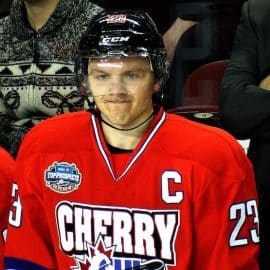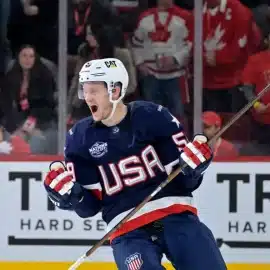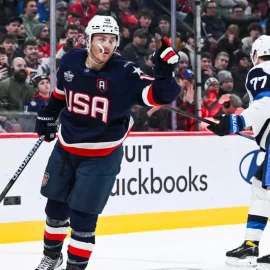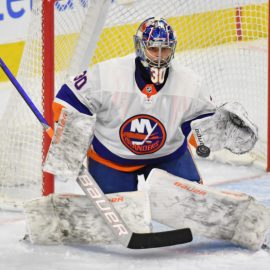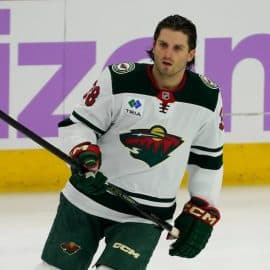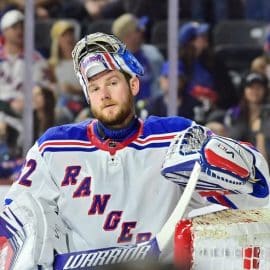When you’ve been on a long journey, every now and then its a good idea to look back and see how far you’ve come. As we celebrate the 50th Anniversary of the Apollo Moon landings, I’m often reminded that beyond the pictures of Neil Armstrong and ‘Buzz’ Aldrin walking on the Moon’s surface it is the picture of the Earth’s image in the background that puts that accomplishment in perspective. With the grind of a sports season, you don’t have time to take that opportunity to look back to see how far you’ve come along.
In 2014, I created an Minnesota Wild: All Time Obscurity team. I did my best to identify players the team soldiered on with that club that perhaps a lot fans have forgotten as well as discussing what those players are up to today. To use words directly from that article, a player had to play at least a full season for the Wild, and as stated before started the respective season with the club. Players had to have played a minimum of 13 games in the NHL and this was done to avoid selecting players who simply had a ‘cup of coffee’ with the team.
As I put that team together, I tried to build it like a team with purpose built lines that included skill players, checkers and even enforcers. So this time around instead of focusing on the obscure (often forgotten) players that plied their careers with the Wild, I decided to focus on the more notable players who once donned the Iron Range Red, Forest Green and Harvest Wheat that played with the team less than 5 seasons. So this will eliminate players like Pascal Dupuis, Andrew Brunette and Eric Staal from being on this team. Like the my Obscurity team, I will form this group as a team with distinct lines and flesh out a complete roster of 12 forwards, 6 defenseman and two goaltenders. Also, I will not have any players the Minnesota Wild drafted themselves (either in the NHL Entry draft or the Expansion draft) so that means we will not have the two best ‘home grown’ talents in team history in Marian Gaborik and Brent Burns on the team.
Many of these notable players had a bigger impact elsewhere than they did with the Minnesota Wild. As you will see, the team is mostly a collection of star talent that was past its prime by the time it arrived in Minnesota as well to other good and above-average (perhaps even below average) players.
Let me get one thing straight before I discuss each of these players. I am not suggesting they all had their best seasons with the Minnesota Wild. These are simply the players who had the most statistically notable careers that played for the team 4-seasons or less. Here are the best lines as I see them in regards to role and skillset.
Demitra-Rolston-Havlat
Vanek-Daigle-Sykora
Heatley-Ronning-Parrish
Madden-Cullen-Nolan
Johnsson-Zidlicky
Leopold-Skoula
Bergeron-Hill
Theodore
Bryzgalov
Forwards
LW – #38 Pavol Demitra (2006-2008) ~ He was the first ‘star’ quality player the Minnesota Wild ever traded for as he was an offensive workhorse with the St. Louis Blues and Los Angeles Kings before arriving in Minnesota. And when they made that trade in the summer of 2006, prior to Twitter it truly came as a surprise to many as the clip below demonstrated (NHL commissioner Gary Bettman‘s amusement over the crowd’s strong reaction is great). The winger was brought in to work along side fellow Slovak Marian Gaborik and were one of the better combinations in franchise history. Demitra had 40 goals and 118 points in two seasons with the Wild, but he didn’t quite take off as some had hoped as a goal scorer. At the time that move demonstrated to the fans and the rest of the league that the organization was finally serious about putting a winning team on the ice. As I wrote for Yahoo!, it was the biggest trade in the team’s early history. Later that same summer the team would open up its purse strings and brought in a whole host of free agents to boost the club from being one of league cast-offs to being a true playoff contender. The team decided to part ways in 2008 and a few seasons later Demitra was out of the league and plying his trade in Russia with Yaroslavl Lokomotiv in the KHL. Sadly, he would lose his life in the plane crash that killed him and all 45 people on board in 2011. Demitra had 304 goals, 768 points in 847 NHL games.
[youtube=https://www.youtube.com/watch?v=JLARiM9t1eY&w=560&h=315]RW – #24/#14 Martin Havlat (2009-2011) ~ The Minnesota Wild signed Havlat to be a go-to scorer after he had a big season with the Blackhawks where he had 29 goals and 77 points. The Wild hoped he’d be able to be the sniping winger the team had been missing since Gaborik had left. Right from the start, Havlat never seemed all that pleased to be in Minnesota and his effort was kind of hit or miss. Even though he may not been overly happy in Minnesota, he had 40 goals and 116 points in 151 games with the Wild over the course of two seasons and tied for the lead in team scoring in the 2010-11 season. The Wild would trade Havlat to the San Jose Sharks for Dany Heatley in the summer of 2011 where his career would fade as injuries caught up to him and by 2016 he was out of the league. Havlat ended his NHL career with 242 goals, 594 points in 790 NHL games.
C – #12 Brian Rolston (2005-2008) ~ The Flint, Michigan-native was signed as a free agent just prior to the 2004-2005 NHL lockout. Playing on a very affordable 3-year, $2.5 million a season contract, Rolston was one of Wild’s best free agent bargains in franchise history. Playing on the team’s 2nd line with set up man Pierre-Marc Bouchard, Rolston was the triggerman and used his cannon-like shot to terrorize opposing goaltenders. His slap shot is probably what he was best remembered for by Wild fans, but he was a decent finisher off the rush and from in close as well. In 241 games with the Wild, he had 96 goals and scored at least 30 goals or more in each of his 3 seasons with the team. No other Wild free agent has delivered with that level of consistency. He was in search of a nice pay raise after the end of the 2008 season and the Wild were not prepared to do so the team traded his rights to Tampa Bay just prior to the NHL Entry draft that year. Rolston’s never quite had the same success over the next 5 seasons and retired in 2012. He finished with 342 goals, 761 points in 1,256 NHL games played.
[youtube=https://www.youtube.com/watch?v=wdajJf3mpUM&w=560&h=315]LW – #26 Thomas Vanek (2014-2016) ~ It was supposed to be a happy reunion when the former Golden Gophers’ star arrived with the Wild. The former Buffalo Sabre who was once seen as so skilled and whose potential was so great that he was once subject to an offer sheet by the Edmonton Oilers. The Sabres’ matched Edmonton’s offer and it made Vanek a $10 million a season contract before he was 25 years old. Once that deal was over he bounced around to a few clubs before he ended up back in Minnesota. It was hoped he’d be a go-to goal scorer that would help round out the Wild’s attack. But early on he frustrated fans by declaring he was going to be a playmaker instead. While Vanek would have some flashes of brilliance with the Wild, scoring 39 goals and 93 points in 154 games it just never seemed to be enough. All too often, Vanek seemed disengaged and fans were expecting more effort and this also appeared to cause troubles with the coaching staff and he was bought out in 2016. Since leaving the Wild he’s only managed short-term contracts on clubs desperate for offense. The 35-year old winger is currently an unrestricted free agent despite having 373 goals, 789 points in his 14-year career thus far.
RW – #17 Petr Sykora (2009-10) ~ He only played 14 games for the Minnesota Wild before demanding to be traded, but Sykora was an important offensively gifted winger throughout most of his NHL career. Starting off with New Jersey in 1995, he was 7th in Calder Trophy voting as the league’s top rookie after netting 18 goals and 42 points. Sykora would go on to win a Stanley Cup with the Devils that year. He continued to be go to scorer for New Jersey, averaging over 20-goals per season over the next 6 seasons. He was traded in a massive player swap in 2002 to the Mighty Ducks of Anaheim that included defenseman Oleg Tverdovsky and winger Jeff Friesen. With the Mighty Ducks, Sykora was a go-to scorer along with Paul Kariya and they swept the Wild in the Western Conference Finals that spring before losing a 7-game series against New Jersey. He’d bounce around to the New York Rangers, Edmonton and Pittsburgh where he won his 2nd Stanley Cup in 2009 before arriving in St. Paul later that fall. He had just 2 goals and 3 points in 14 games and suffered a concussion in a game against Dallas, but he clearly wasn’t happy with how he was being used and the team released him from his contract and he returned to his homeland of Czech Republic. After playing a season in the Czech Superleague he returned to the NHL for one more season where it all started, in New Jersey before retiring in 2012. Sykora had 323 goals, 721 points in 1,017 NHL games.
C – #9 Alexandre Daigle (2003-06) ~ In the months before he was drafted 1st Overall, he was called “Alexander the Great” as many felt he’d be a generational talent. It didn’t work out that way as he mostly just teased at the great skill he possessed in his 4 1/2 seasons with the Senators topping out with two 51-point seasons. He’d be traded to Philadelphia but struggled to be effective. Perhaps his heart wasn’t in it as he’d leave the game for a few seasons to try his hand at acting. But he’d get the bug to return to the game in 2003 and attracted interest from Minnesota. The Wild weren’t taking any chances with Daigle as they signed him to a 3-way deal, because they didn’t want the possibility of over paying him to play in the ECHL. With the contract holdouts of Gaborik and Dupuis during the first half of the season, Daigle found himself with lots of ice time and opportunity and gave the Wild one of his best seasons with 20 goals, 51 points to lead the team in scoring in 2003-04. Then the 2004-05 NHL lockout robbed him of the momentum of a potential comeback and he kind of lost out in the numbers game in Minnesota and by 2006 the Wild let him go. He’d play a few more years in Switzerland before retiring from hockey once and for all in 2010. Daigle had 126 goals, 327 points in 616 NHL games.
LW – #15 Dany Heatley (2011-2014) ~ The player that was drafted one pick before Minnesota took Marian Gaborik with its first-ever 1st round pick in 2000 had lofty expectations being selected 2nd Overall by the Atlanta Thrashers. Heatley was an absolute beast at the University of Wisconsin and his transition to the NHL was equally impressive where he established himself as one of the league’s best goal scorers along side teammate Ilya Kovalchuk. That fast start would come to a tragic end after he was involved in a car crash that took the life of teammate Dan Snyder. In the wake of the tragedy, which revealed Heatley was driving recklessly and far too fast on residential streets the Thrashers traded him to Ottawa. The Senators were a team on the rise at this point and Heatley had back-to-back 50-goal seasons and two others where he scored 41 goals and 39 goals respectively and helped lead Ottawa to the Stanley Cup finals in 2006-07. It was here where his game and his legs started to fade and after playing two seasons with San Jose he was dealt to Minnesota for Martin Havlat. Wild fans were hoping he could rediscover that scoring touch but the game was getting faster while Heatley struggled to keep up with the pace and the offensive production continued to decline. With a lack of offensive production his role with the team was reduced to being mostly used as a power play specialist and eventually the team let him go. He would play one more year playing in just 6 games in Anaheim. Heatley had 372 goals, 791 points in 869 career NHL games.
[youtube=https://www.youtube.com/watch?v=py0QwtA6-8c&w=560&h=315]RW – #21 Mark Parrish (2006-2008) ~ the Bloomington Jefferson star won a few state tournaments with the dynasty that was the Jaguars before starring for an excellent St. Cloud State team before starting his NHL career with the Florida Panthers. After two promising seasons he was dealt to the New York Islanders as part of the ‘first’ Roberto Luongo trade. Parrish then continued to show plenty of promise as a goal mouth sniper regularly scoring over 20-goals the next 5 seasons, much in the same way as his childhood hero Dino Ciccarelli had done with the Minnesota North Stars when he was growing up. As Minnesota tried to open up the purse strings to be a playoff competitor in this new salary cap world would sign Parrish to a 5-year contract where they hoped he’d be that same goal-mouth scoring presence. It didn’t quite turn out that way as the goals were tougher to come by and with a game that emphasizing more and more speed along with Parrish’s lack of versatility his role steadily started to shrink. After two seasons with the Wild where he had 35 goals, 69 points in 142 games the team decided to buy him out. Parrish, still being paid by the Wild not to play for them bounced from Dallas, to Tampa Bay and then to Buffalo before retiring from hockey at the end of the 2010-11 season. He had 216 goals, 387 points in 722 NHL games.
[youtube=https://www.youtube.com/watch?v=PJUyULl3dGo&w=560&h=315]C – #7 Cliff Ronning (2002-2003) ~ The smallish center from Burnaby, British Columbia was nearly a point-per-game player (328 points in 366 games) in the 6 seasons he played for the Vancouver Canucks from 1991 to 1996. He would play the next few seasons with Phoenix and Nashville and after a brief stint with the Los Angeles Kings he made his way to St. Paul in 2002-03. The veteran was most prominent as the team’s power play quarterback manning the point and distributing the puck. He had 17 goals, 48 points that season and helped provide some important secondary scoring on a team that mostly scored by committee. Despite playing on a fairly modest contract, the Wild decided to not re-sign him over an issue of around $300,000. The Wild at that time had one of the league’s lowest payrolls and were not going to budge so Ronning played just one more season with the New York Islanders before retiring in 2004 with 306 goals, 869 points in 1,137 career games.
LW/C – #11 John Madden (2010-11) ~ After a stellar career at the University of Michigan, John Madden burst into the NHL in 1999-00 season and quickly established himself as one of the top defensive forwards of his era. Madden’s speed, hustle and tenacity on the puck made him a key part of 3 Stanley Cup Championships, twice with the New Jersey Devils and once with the Chicago Blackhawks. He won the Selke Award as the league’s top defensive forward in the 2000-01 season and was a finalist for it 3 more times. While mostly known for his defensive prowess, he was also a clutch scorer and usually averaged between 30-40 points per season throughout most of his 13-year NHL career. By the time he arrived with the Wild he was fresh off a Stanley Cup with Chicago and played just one season in Minnesota scoring 12 goals and 25 points. Madden finished his NHL career with 165 goals, 348 points in 898 games.
RW – #11 Owen Nolan (2008-2010) ~ Another player that was a former 1st Overall pick in 1990, he mostly lived up to the expectations. He was a power forward who had terrific hands and feisty nature he put up big seasons with the Quebec Nordiques and San Jose Sharks posting 6 seasons where he had 30 or more goals. He is perhaps best known for ‘calling his shot’ in the 1997 All Star Game where he scored his 3rd goal of the game beating Dominik Hasek with a wicked snap shot. He was in the twilight of his career by the time he arrived in Minnesota but he still demonstrated he still had terrific hands as he surprised many by lighting the lamp 25 times in the 2008-09 season and then added another 16 the next year before retiring that summer. Nolan was especially good at deflecting pucks and was a great finisher around the net as this highlight video will demonstrate. The Belfast, Northern Ireland-born winger had 422 goals, 885 points in 1,200 NHL games.
[youtube=https://www.youtube.com/watch?v=IGK79s6iibI&w=560&h=315]C – #7 Matt Cullen (2010-2013, 2017-18) ~ Matt Cullen just finally retired this summer after an impressive 21-year NHL career and he is the only player on this list that played in two separate stints with the Wild. The former Moorhead Spuds star started out with the Mighty Ducks of Anaheim before moving on with short stints in Florida and the New York Rangers before settling in Carolina. With the Hurricanes he’d win his first of three Stanley Cups in 2006. Then eventually he’d make his way to Minnesota where he was fixture on the team’s 3rd line and like Madden was probably more known for his defensive game but he had clutch scoring instincts as well. Cullen had two seasons with at least 20-goals and many with numbers in the mid-teens which was a big reason he was able to have such a long career. He also kept his body in immaculate shape. The former St. Cloud State Huskie had 33 goals and 101 points in his first 193-game stint with the Wild. He left the Wild to go and play for Pittsburgh and Cullen went onto win back-to-back Stanley Cups with the Penguins, Minnesota seemed to bring him back for sort of ‘home lap’ season. It was kind of awkward and he never seemed to establish any stable linemates with the constant juggling being done by Wild Head Coach Bruce Boudreau and the team parted ways with him after one more season where he had just 11 goals and 22 points. He’d play one more year with the Penguins before hanging up the axe, retiring with 266 goals, 731 points in 1,516 NHL games which is the most ever by a Minnesota-native.
[youtube=https://www.youtube.com/watch?v=kajIuwMY4RI&w=560&h=315]Defenseman
LD – #5 Kim Johnsson (2006-2010) ~ The previously mentioned trade for Pavol Demitra witnessed the Wild make a number of significant free-agent signings to bolster their roster into a consistent contender for the playoffs. This also involved improving the team’s blueline and the team added a defenseman they felt they could rely on for big minutes in Kim Johnsson. Johnsson had been steadily improving since being drafted by the New York Rangers and really started to come into his own with the Philadelphia Flyers. When Johnsson arrived, his calm, unassuming game seemed to fit in well with Jacques Lemaire‘s system even though his offensive production was a little less than what he had in his time in Philadelphia. He had 15 goals, 87 points in 289 games with the Wild. Some fans were irked by the lack of offensive production, but Johnsson was steady in his own end. In 2008, he was sucker punched by Brad May in the playoffs against the Anaheim Ducks and was never quite the same. He’d play one more season in Minnesota and was then dealt to Chicago along with Nick Leddy as part of the ill-fated trade for Cam Barker. He would get hurt shortly after arriving with the Blackhawks and was forced to retire from the game due to concussion issues. Johnsson had 67 goals, 284 points in 739 NHL games.
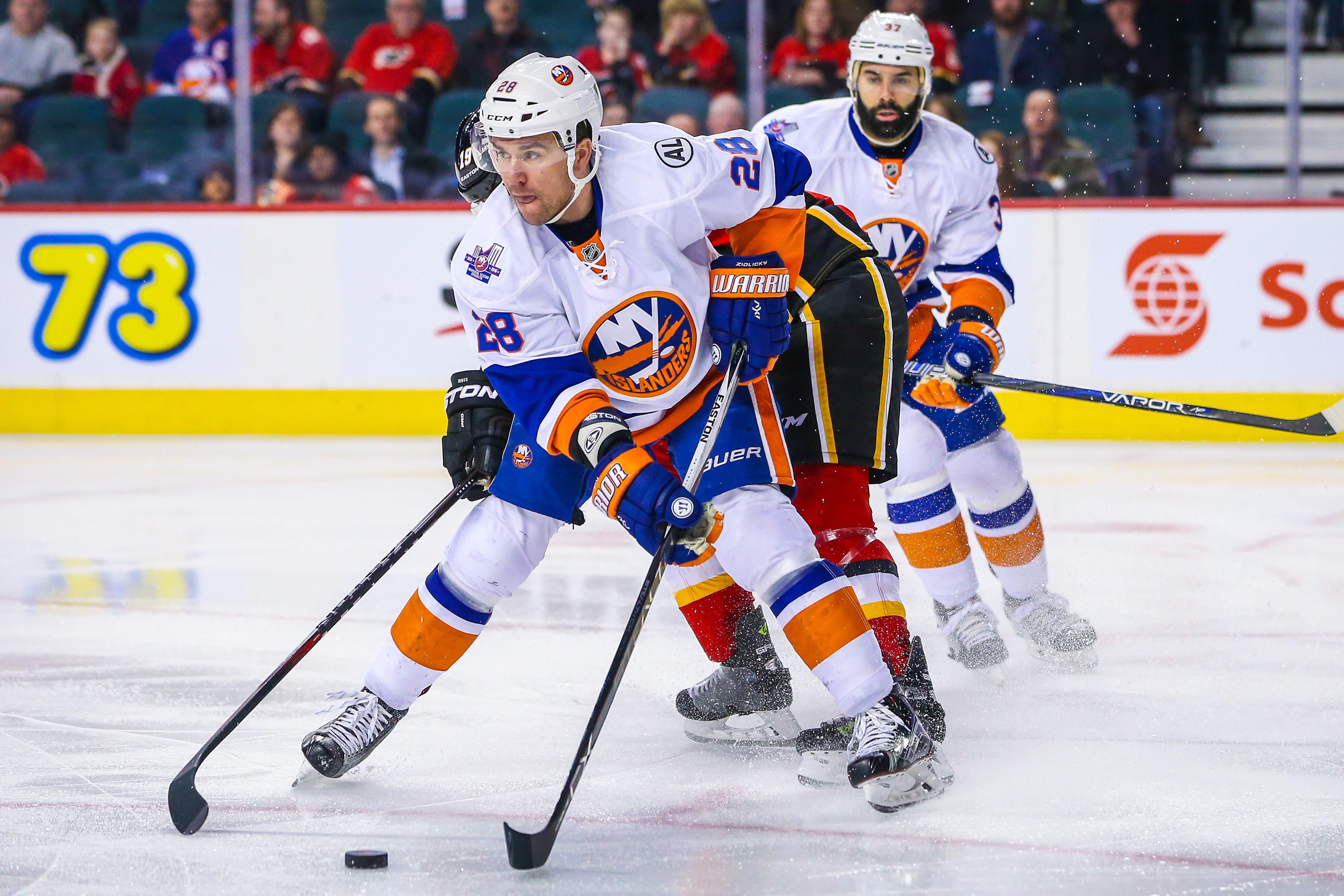
RD – #3 Marek Zidlicky (2008-2012) ~ The Wild was looking for more offensive punch from its blueline so they acquired the somewhat mercurial offensive defenseman. Zidlicky was drafted by the Rangers but got his start with the Nashville Predators. With the Predators he took advantage of a booming shot on the power play, but he was also prone to defensive gaffes. The Wild felt pretty good about their defensive game, so adding Zidlicky seemed like less of a risk. Once he arrived he never seemed to be truly happy (and was it just me, but he seemed to want his name pronounced a different way each season he was here) and his offensive production wasn’t quite what it was when he was with Nashville. He had 25 goals, 123 points in 241 games with the Wild. The Wild eventually would trade Zidlicky to New Jersey where his game briefly caught fire again but he’d only play 5 more seasons before finishing his career with the New York Islanders. Zidlicky had 89 goals, 417 points in 836 NHL games.
LD – #33 Jordan Leopold (2014-15) ~ He only played 18 regular season games for the Minnesota Wild which is the 2nd shortest length of time for any player on this team. But after his senior year with the University of Minnesota where he won the Hobey Baker Award as college hockey’s top player he stepped right into playing 20 minutes a game with the Calgary Flames. Leopold’s ability to move and distribute the puck as well as playing responsibly in his own end indicated he had a bright future in the NHL. In his 2nd NHL season, playing on the Flames Top 4 he came just centimeters from winning a Stanley Cup as Calgary was edged out by the Tampa Bay Lightning in 2004. He then spent time with Florida and Pittsburgh before re-kindling his game in Buffalo. With the Sabres he re-established his offensive game but another NHL lockout in 2012 kind of deflated that momentum. During the lockout shortened season that followed he was dealt to St. Louis and struggled to get the ice time and opportunity he once had. During the 2014-15 season he was languishing in Columbus when the Blue Jackets dealt him to Minnesota at the deadline in a trade that got far more publicity because of a letter his young daughter wrote to the team asking them to trade him to the Wild. When he arrived in Minnesota has put in a mentorship kind of role in a pairing with Matthew Dumba. Leopold had just 1 assist in the 18 games he played in Minnesota. He retired after that season. The former St. Louis Park star had 67 goals, 214 points in 695 NHL games.
LD – #41 Martin Skoula (2005-2009) ~ When the Czech-born defenseman made his NHL debut with the Avalanche he seemed to be another decent player out of a internal pipeline of talent (Milan Hejduk, Chris Drury, Dan Hinote) that kept Colorado among the Western Conference’s elite teams. He seemed to be a promising two-way defenseman who had decent mobility and a good point shot. He played a significant role in Colorado’s Top 4 as they won the Stanley Cup in 2001. After the 2002-03 season his game started a slow but steady decline. He had short and mostly unsuccessful stints with the Mighty Ducks and Stars and he needed a change of scenery. The Wild would trade Willie Mitchell and a 2nd round pick to Dallas in exchange for Skoula and Shawn Belle. It was hoped he would rediscover his game with more ice time and opportunity than he had received in Dallas and Anaheim. It didn’t go so well. The offensive part of his game was mostly absent and to make matters worse he seemed to be terribly mistake prone. The fact Skoula was acquired by dealing away one of Minnesota’s most dependable defenseman did not help and he quickly became a whipping boy among fans. He would be let go after the 2008-09 season. He played one more year split between Pittsburgh and New Jersey before leaving the NHL altogether and he’d take his game back to Europe for a few more seasons before retiring from hockey altogether in 2012. Skoula had 44 goals, 196 points in 776 NHL games.
LD – #47 Marc-Andre Bergeron (2008-2009) ~ The Quebec-native is one of those players who I never quite understood why he didn’t get more of an opportunity than he did. While he was a smaller defenseman, he possessed an absolute bullet of a shot and was fairly productive in the places that gave him a chance to succeed. He started out with the Edmonton Oilers and started to make his presence (i.e. his cannon of a shot) felt in 2002-03 with a 15 goal season. But his defensive issues seemed to make coaching staffs sour on his game and he was traded to the New York Islanders and the Anaheim Ducks before making his way to the Wild who traded a 3rd round pick for him. Bergeron had one of his better seasons, scoring 14 goals and 32 points and finished the season with +5 in 72 games. Yet Minnesota decided to move on from Bergeron and continued to bounce around the league going to Montreal, Tampa Bay before finishing up his NHL career in Carolina in 2012. Watch #4 goal in the clip below and I think you’ll be hard pressed to find a harder shot ever unleashed in Wild history. Bergeron finished with 82 goals, 235 points in 490 NHL games.
[youtube=https://www.youtube.com/watch?v=lfItdC7Op4w&w=560&h=315]RD – #6 Sean Hill (2007-2008) ~ the former Duluth East star had an eventful start to his NHL career by winning a Stanley Cup with the Montreal Canadiens in 1993. He was traded the following summer to the Mighty Ducks of Anaheim and then moved to the Ottawa Senators. Hill was a two-way defenseman who had a dose of sandpaper to his game, and in his prime he had a pretty decent shot as well. After 4 seasons with the Senators he’d get moved to Carolina where he had the most success of his career. The 2003-04 lockout was not kind to Hill whose game really seemed to struggle with the greater emphasis on speed after the league got rid of the two-line pass. By the time he arrived in Minnesota, it was under dubious circumstances as he had 18-games of a 20-game suspension for using performance enhancing drugs. When he finally played for the Wild he looked tired and as though he lost a step or two. He had just 2 goals and was a -16 in just 35 games with Minnesota. With his NHL career at an end he’d play one more season in Switzerland before retiring from hockey in 2009. Hill had 62 goals, 298 points in 876 NHL games.
Goaltenders
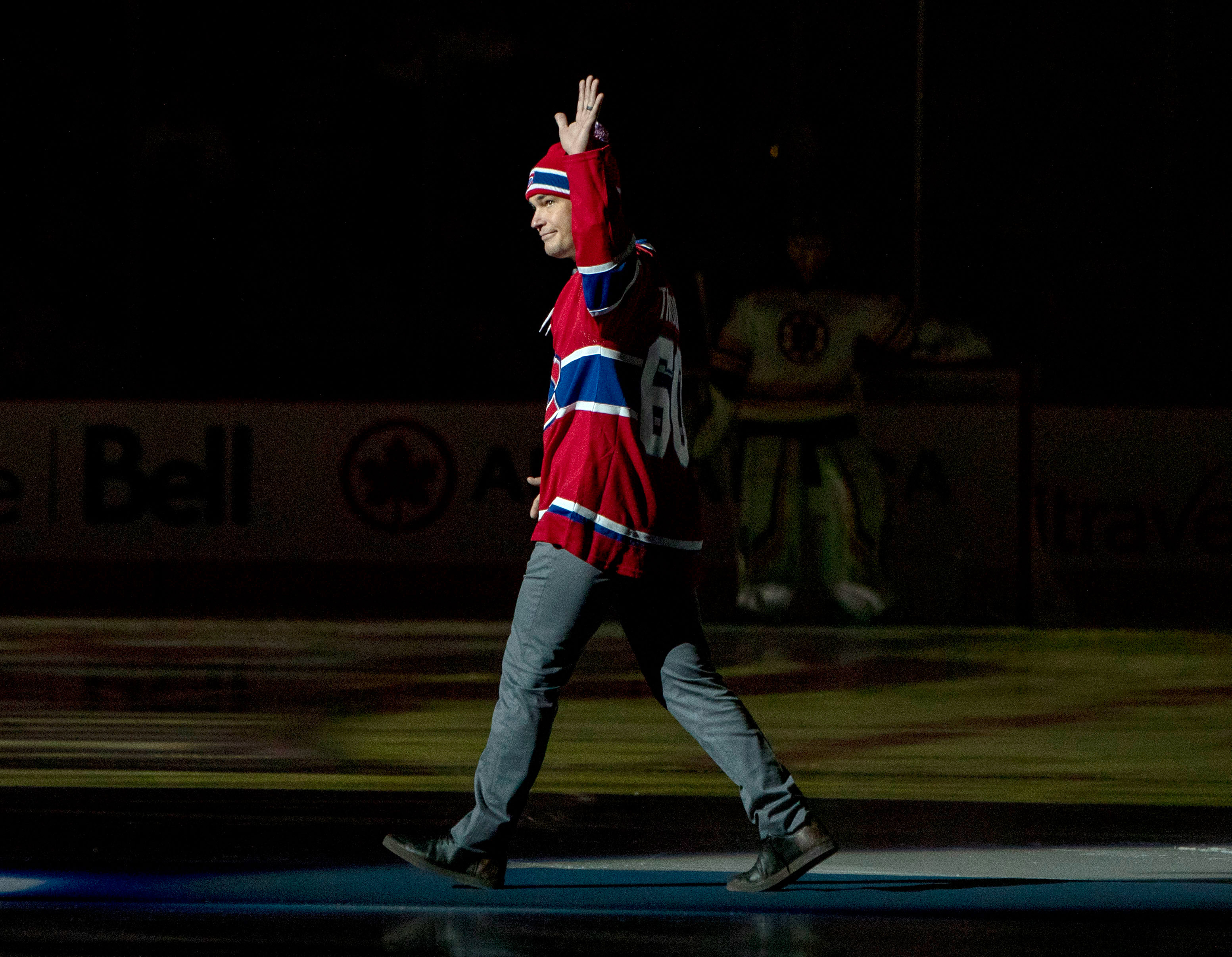
#60 Jose Theodore (2010-11) ~ In today’s day in age of big goaltenders Jose Theodore defied that trend at just 5’11” and used great athleticism and technical skill to make up that difference. Being a rare right-catching goalie didn’t hurt either. Theodore had to deal with the pressure of being a Francophone player playing in Montreal but his improvement was steady. In 2001-02 season, Theodore won the Vezina Trophy as the league’s top goalie and the Hart Trophy as the league MVP after posting a 30-24-10 record, 2.11 goals against average and a gaudy .931% save percentage. He would play a few more seasons with the Canadiens before being dealt to Colorado for David Aebischer. After two seasons with the Avalanche he’d sign on as a free agent with the Washington Capitals. It was here Theodore would have to endure one of the toughest periods of his life in 2009 as his young son Chace died due to complications dealing with premature birth. Despite the tragedy, Theodore had a decent season for the Capitals and won the Masterton Trophy in 2010. The Wild would sign Theodore to back up Niklas Backstrom. He did reasonably well, posting a 15-11-3 record, 2.71 goals against average and a .916% save percentage. The following season Theodore would take his game to Florida where he’d lead the Panthers to its first playoff appearance in over a decade. He’d play one more season with the Panthers before retiring from the NHL at the end of the 2012-13 season. He had a record of 286-254-69, 2.68 goals against average and a .909% save percentage with 33 shutouts.
#30 Ilya Bryzgalov (2013-14) ~ The Russian goaltender is one of the league’s more colorful personalities who was always a hit with sports reporters hoping to break up the monotony of cliches for truly bizarre comments on time and space among other things. As he got his NHL career going, he was on the bench to watch the Anaheim Ducks win the Stanley Cup in 2007. The Ducks would claim Bryzgalov off waivers the following year and he quickly became the Coyotes’ starter. It wasn’t easy to win with the Coyotes, team always starved of offense but Bryzgalov gave them a chance to win most nights even leading Phoenix to the playoffs a few times. This even made Bryzgalov the runner up for the Vezina Trophy in 2010. Bryzgalov then would be traded to Philadelphia where they hoped he’d finally answer their goalie conundrum. It didn’t quite work out that way and after two roller coaster seasons with the Flyers he was bought out. Bryzgalov would take his game to Edmonton where his game was looking pretty rough by the time the Wild would come calling in the spring of 2014. With Backstrom injured and Josh Harding battling symptoms related to Multiple Sclerosis and not feeling completely confident in Darcy Kuemper to the team needed another puckstopper. The Wild dealt a 4th round pick for Bryzgalov who more or less was tasked with trying to save Minnesota’s season. The loose, easy going Bryzgalov appeared to re-establish his game and he’d split time with Kuemper and posted a respectable 7-1-3 and 2.12 goals against average and a .911 save percentage. Unfortunately it wasn’t enough to get Minnesota beyond the 1st round of the playoffs. Bryzgalov would play just one more season with the Ducks before retiring from hockey altogether in 2015. He had a career record of 221-165-54, 2.58 goals against average and a .912 save percentage with 34 shutouts.
Was this the best list of Minnesota Wild players that fit those requirements in your opinion? Who did we miss and what do you remember of these players in their time with Minnesota? Either way we hope you enjoyed this trip down Minnesota Wild memory lane. Tell us on Twitter @CreaseAndAssist or in the comment section below!
Add The Sports Daily to your Google News Feed!


